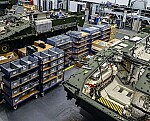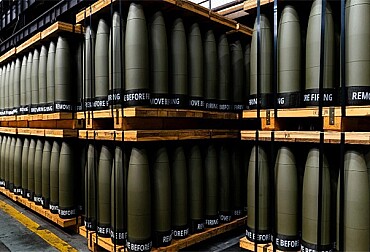Ukraine conflict: Lessons for the U.S. Military and Intelligence Community
The ongoing conflict in Ukraine has provided a rich ground for learning and innovation for military strategists worldwide. For over two and a half years, this large-scale combat scenario has challenged conventional warfare paradigms, offering new insights into unmanned systems, electronic warfare, and information operations. U.S. military intelligence officials, in particular, have been keen observers, gleaning valuable lessons from Ukraine’s defense against Russia’s invasion. These lessons were shared by top officials at the Intelligence and National Security Alliance (INSA) annual conference in Washington, highlighting key takeaways in maritime, space, online, and land warfare domains.

Maritime Warfare: The power of asymmetric and unmanned capabilities
Ukraine's maritime defense has upended traditional notions of naval power. Despite Russia’s formidable naval fleet, Ukraine has managed to disrupt and contain Russian naval operations using a combination of asymmetric tactics and unmanned systems. Vice Adm. Karl Thomas, Director of Naval Intelligence, emphasized the critical lesson learned from the sinking of the Russian Slava-class cruiser, Moskva, by Ukrainian Neptune cruise missiles in April 2022. This incident underscored the importance of anti-ship cruise missile defense and demonstrated the potential of smaller, unmanned vessels to challenge conventional navies.
Thomas praised Ukraine’s innovative use of unmanned surface and underwater vessels to execute dangerous missions that would typically require manned crews. These tactics have effectively pinned the Russian Black Sea Fleet to the eastern side of the Black Sea. The lesson for the U.S. Navy is clear: investing in smaller, cost-effective unmanned systems could yield outsized operational impacts, especially in contested environments.
Space Operations: Leveraging commercial imagery for strategic advantage
In the space domain, the conflict has underscored the value of commercial satellite imagery for intelligence and diplomacy. Maj. Gen. Gregory Gagnon, Deputy Chief of Space Operations for Intelligence at the U.S. Space Force, highlighted the role of commercial remote sensing in the months leading up to Russia's invasion. U.S. officials used unclassified commercial imagery to build a case for Russia's impending actions, enabling them to secure international support and enhance diplomatic efforts.
This strategic use of commercial satellite imagery allowed the U.S. to empower its allies by providing them with credible, shareable evidence. Unlike previous conflicts where intelligence was kept within secure facilities, this approach enabled public dissemination, bolstering international consensus and support against Russia’s aggression.
Information Warfare: Dominating the digital battlefield
The Ukraine conflict has also spotlighted the critical importance of information warfare. According to Brig. Gen. William Wilburn, Jr., of the U.S. Marine Corps, the information space has become a key battleground. Both Ukrainian and Russian forces have aggressively utilized social media and other digital platforms to influence global public opinion, disseminate information, and sometimes engage in misinformation and disinformation.
This real-time battle for the narrative is something the U.S. military needs to be prepared for in future conflicts. As Wilburn noted, those who master the art of digital communication and can effectively counter misinformation will have a distinct advantage. Conversely, those who fail to adapt to this new paradigm risk being outmaneuvered in the information domain.
Land Warfare: Drones and the future of electronic warfare
On the ground, the conflict in Ukraine has demonstrated the transformative potential of cheap, unmanned aerial vehicles (UAVs) and advanced electronic warfare (EW) capabilities. Andrew Evans, Director of the Army’s ISR Task Force, pointed out the remarkable return on investment seen in the battlefield use of drones. In many instances, $500 UAVs have effectively neutralized $20 million armored vehicles, forcing a reevaluation of acquisition strategies and battlefield tactics.
Additionally, the dynamic and ever-evolving nature of electronic warfare in Ukraine has highlighted the need for continuous adaptation and innovation. Evans expressed concerns about the U.S. Army’s underinvestment in both offensive and defensive EW capabilities. He stressed the importance of EW "reprogramming" – the ability to rapidly adjust tactics in response to an adversary’s countermeasures. This capability will be crucial in maintaining a tactical edge in future conflicts.
Conclusion
The Ukraine conflict serves as a stark reminder of the evolving nature of modern warfare and the importance of innovation and adaptability. U.S. military and intelligence officials have gained valuable insights from Ukraine’s defense strategies, particularly in leveraging asymmetric tactics, unmanned systems, commercial imagery, and information operations. As the nature of warfare continues to evolve, these lessons will be instrumental in shaping future U.S. military doctrine and strategic planning. The ability to innovate and adapt, as demonstrated by Ukraine, may very well be the deciding factor in future conflicts.









